engine YAMAHA V1 2015 Owner's Manual
[x] Cancel search | Manufacturer: YAMAHA, Model Year: 2015, Model line: V1, Model: YAMAHA V1 2015Pages: 94, PDF Size: 3.01 MB
Page 43 of 94
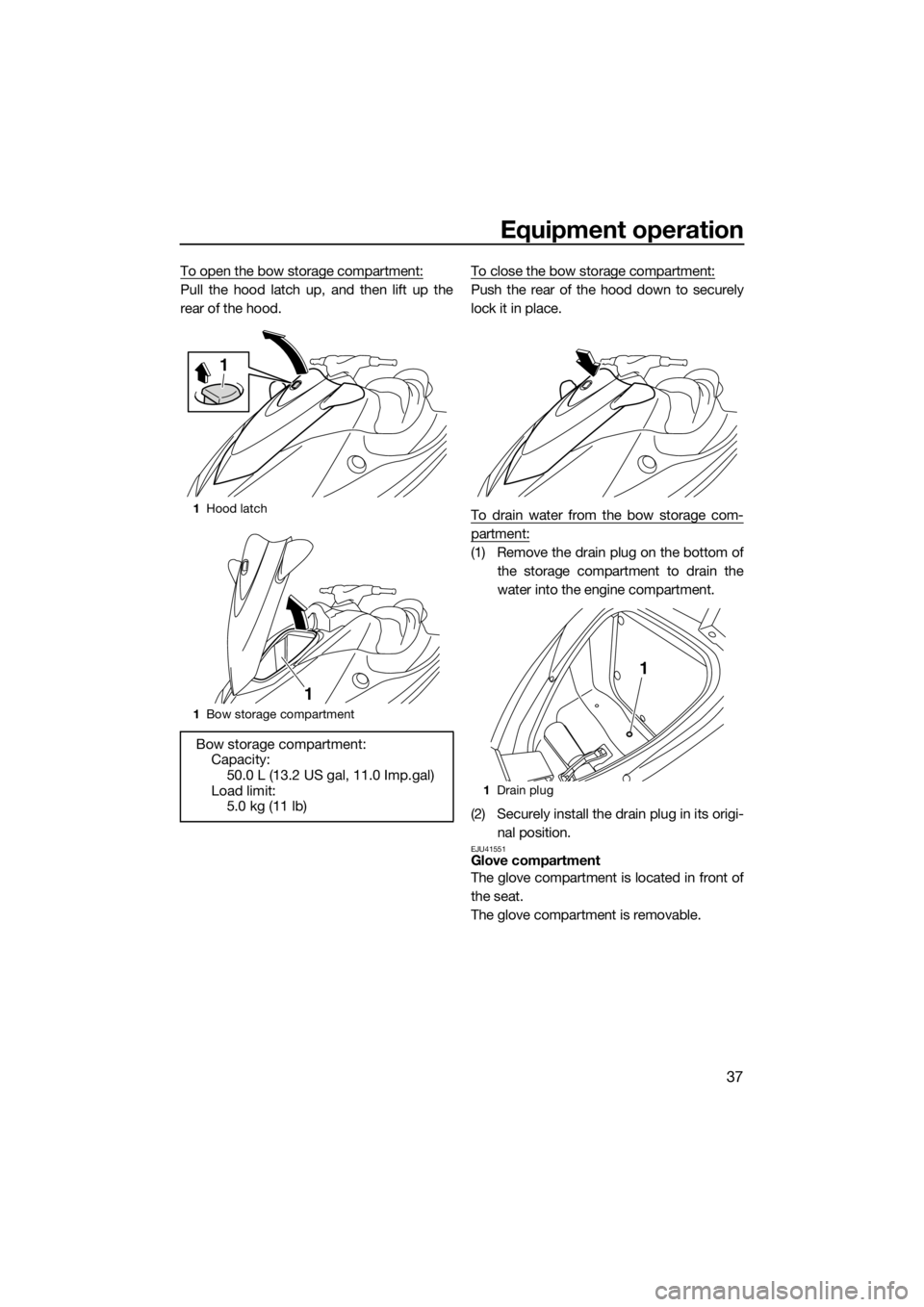
Equipment operation
37
To open the bow storage compartment:
Pull the hood latch up, and then lift up the
rear of the hood.To close the bow storage compartment:Push the rear of the hood down to securely
lock it in place.
To drain water from the bow storage com-
partment:
(1) Remove the drain plug on the bottom of
the storage compartment to drain the
water into the engine compartment.
(2) Securely install the drain plug in its origi-
nal position.
EJU41551Glove compartment
The glove compartment is located in front of
the seat.
The glove compartment is removable.
1Hood latch
1Bow storage compartment
Bow storage compartment:
Capacity:
50.0 L (13.2 US gal, 11.0 Imp.gal)
Load limit:
5.0 kg (11 lb)
1
1
1Drain plug
1
UF2P72E0.book Page 37 Tuesday, August 26, 2014 10:08 AM
Page 46 of 94
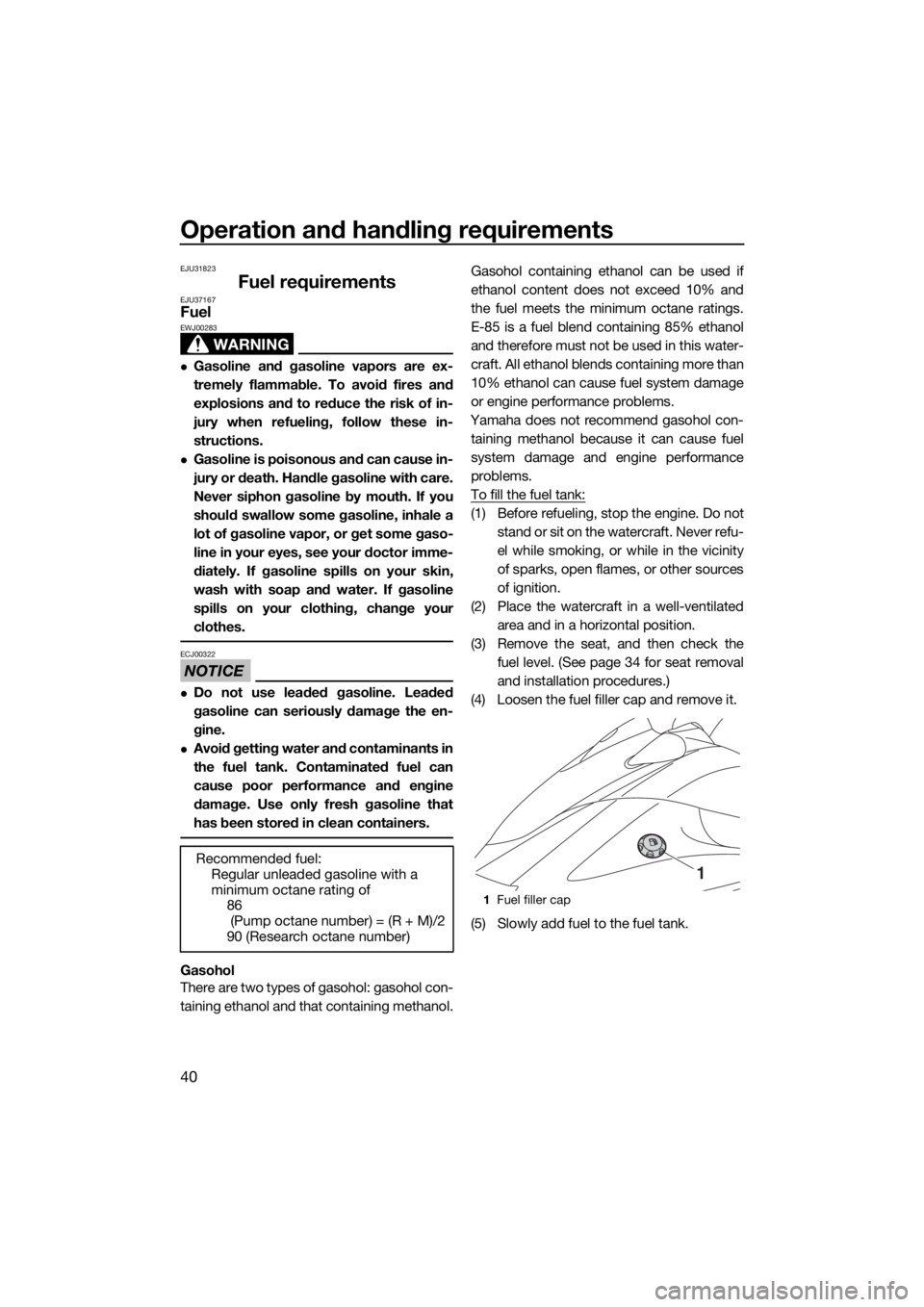
Operation and handling requirements
40
EJU31823
Fuel requirementsEJU37167Fuel
WARNING
EWJ00283
Gasoline and gasoline vapors are ex-
tremely flammable. To avoid fires and
explosions and to reduce the risk of in-
jury when refueling, follow these in-
structions.
Gasoline is poisonous and can cause in-
jury or death. Handle gasoline with care.
Never siphon gasoline by mouth. If you
should swallow some gasoline, inhale a
lot of gasoline vapor, or get some gaso-
line in your eyes, see your doctor imme-
diately. If gasoline spills on your skin,
wash with soap and water. If gasoline
spills on your clothing, change your
clothes.
NOTICE
ECJ00322
Do not use leaded gasoline. Leaded
gasoline can seriously damage the en-
gine.
Avoid getting water and contaminants in
the fuel tank. Contaminated fuel can
cause poor performance and engine
damage. Use only fresh gasoline that
has been stored in clean containers.
Gasohol
There are two types of gasohol: gasohol con-
taining ethanol and that containing methanol.Gasohol containing ethanol can be used if
ethanol content does not exceed 10% and
the fuel meets the minimum octane ratings.
E-85 is a fuel blend containing 85% ethanol
and therefore must not be used in this water-
craft. All ethanol blends containing more than
10% ethanol can cause fuel system damage
or engine performance problems.
Yamaha does not recommend gasohol con-
taining methanol because it can cause fuel
system damage and engine performance
problems.
To fill the fuel tank:
(1) Before refueling, stop the engine. Do not
stand or sit on the watercraft. Never refu-
el while smoking, or while in the vicinity
of sparks, open flames, or other sources
of ignition.
(2) Place the watercraft in a well-ventilated
area and in a horizontal position.
(3) Remove the seat, and then check the
fuel level. (See page 34 for seat removal
and installation procedures.)
(4) Loosen the fuel filler cap and remove it.
(5) Slowly add fuel to the fuel tank. Recommended fuel:
Regular unleaded gasoline with a
minimum octane rating of
86
(Pump octane number) = (R + M)/2
90 (Research octane number)
1Fuel filler cap
1
UF2P72E0.book Page 40 Tuesday, August 26, 2014 10:08 AM
Page 47 of 94
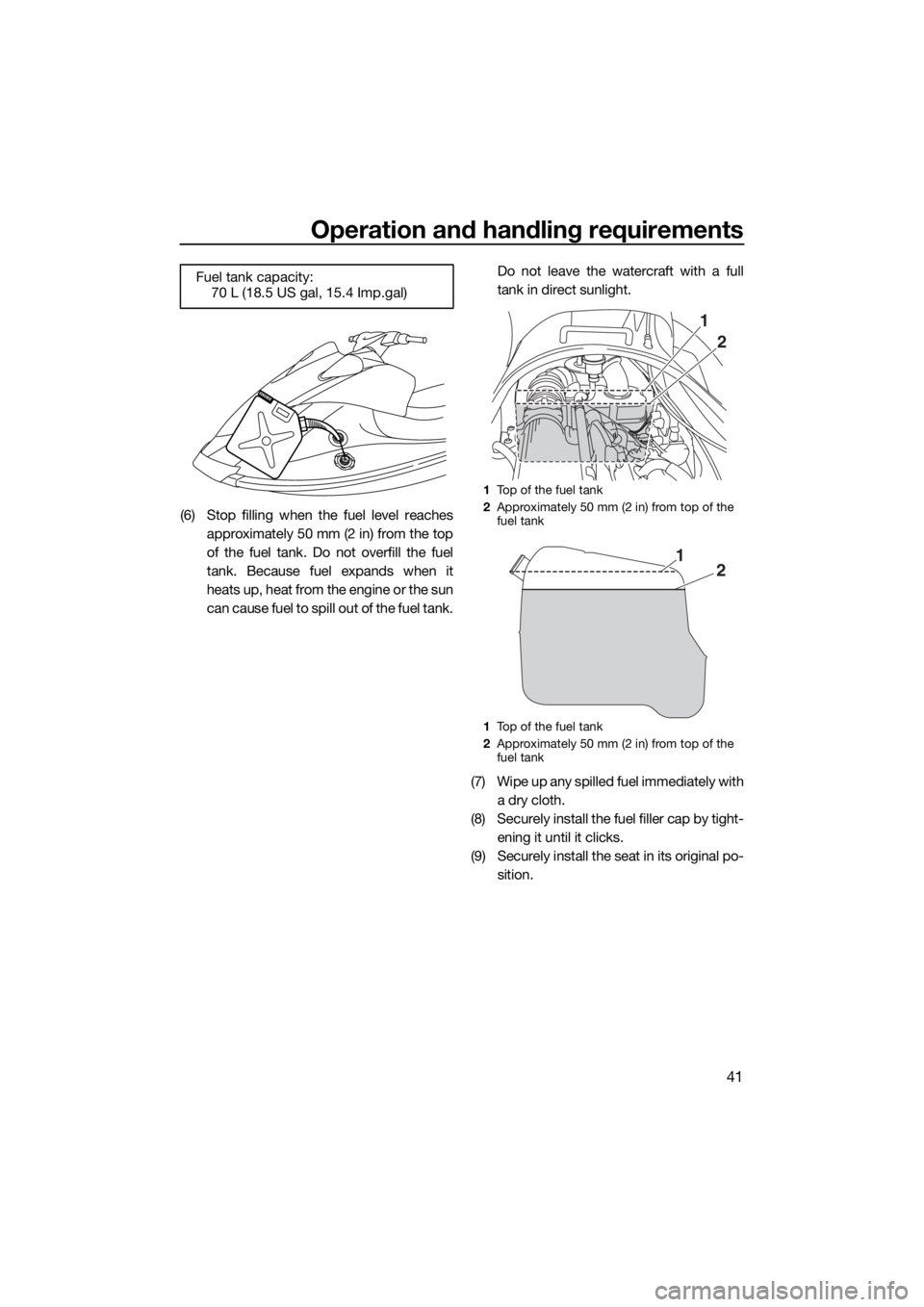
Operation and handling requirements
41
(6) Stop filling when the fuel level reaches
approximately 50 mm (2 in) from the top
of the fuel tank. Do not overfill the fuel
tank. Because fuel expands when it
heats up, heat from the engine or the sun
can cause fuel to spill out of the fuel tank.Do not leave the watercraft with a full
tank in direct sunlight.
(7) Wipe up any spilled fuel immediately with
a dry cloth.
(8) Securely install the fuel filler cap by tight-
ening it until it clicks.
(9) Securely install the seat in its original po-
sition. Fuel tank capacity:
70 L (18.5 US gal, 15.4 Imp.gal)
1Top of the fuel tank
2Approximately 50 mm (2 in) from top of the
fuel tank
1Top of the fuel tank
2Approximately 50 mm (2 in) from top of the
fuel tank
2
1
21
UF2P72E0.book Page 41 Tuesday, August 26, 2014 10:08 AM
Page 48 of 94
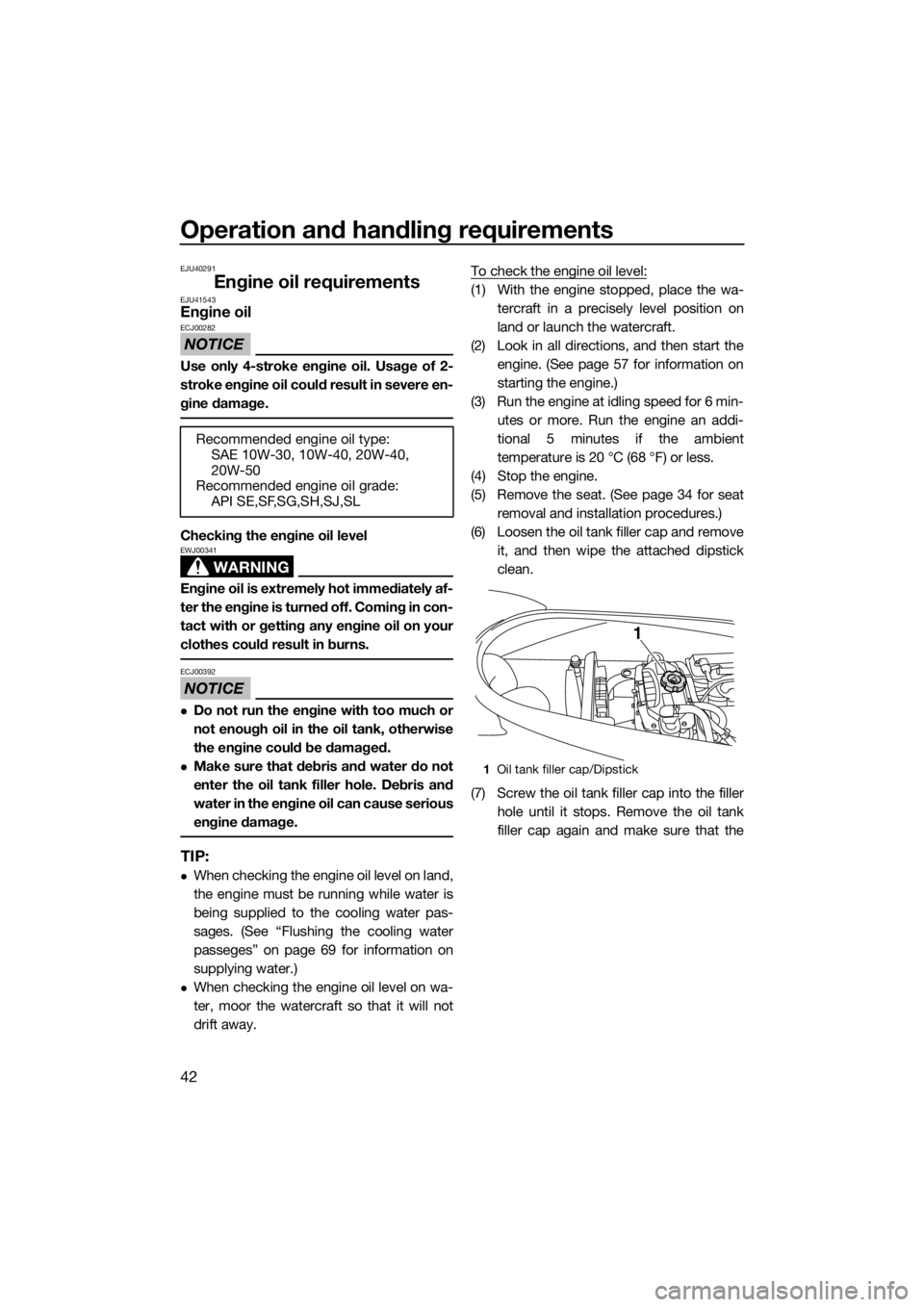
Operation and handling requirements
42
EJU40291
Engine oil requirementsEJU41543Engine oil
NOTICE
ECJ00282
Use only 4-stroke engine oil. Usage of 2-
stroke engine oil could result in severe en-
gine damage.
Checking the engine oil level
WARNING
EWJ00341
Engine oil is extremely hot immediately af-
ter the engine is turned off. Coming in con-
tact with or getting any engine oil on your
clothes could result in burns.
NOTICE
ECJ00392
Do not run the engine with too much or
not enough oil in the oil tank, otherwise
the engine could be damaged.
Make sure that debris and water do not
enter the oil tank filler hole. Debris and
water in the engine oil can cause serious
engine damage.
TIP:
When checking the engine oil level on land,
the engine must be running while water is
being supplied to the cooling water pas-
sages. (See “Flushing the cooling water
passeges” on page 69 for information on
supplying water.)
When checking the engine oil level on wa-
ter, moor the watercraft so that it will not
drift away.To check the engine oil level:
(1) With the engine stopped, place the wa-
tercraft in a precisely level position on
land or launch the watercraft.
(2) Look in all directions, and then start the
engine. (See page 57 for information on
starting the engine.)
(3) Run the engine at idling speed for 6 min-
utes or more. Run the engine an addi-
tional 5 minutes if the ambient
temperature is 20 °C (68 °F) or less.
(4) Stop the engine.
(5) Remove the seat. (See page 34 for seat
removal and installation procedures.)
(6) Loosen the oil tank filler cap and remove
it, and then wipe the attached dipstick
clean.
(7) Screw the oil tank filler cap into the filler
hole until it stops. Remove the oil tank
filler cap again and make sure that the Recommended engine oil type:
SAE 10W-30, 10W-40, 20W-40,
20W-50
Recommended engine oil grade:
API SE,SF,SG,SH,SJ,SL
1Oil tank filler cap/Dipstick
1
UF2P72E0.book Page 42 Tuesday, August 26, 2014 10:08 AM
Page 49 of 94
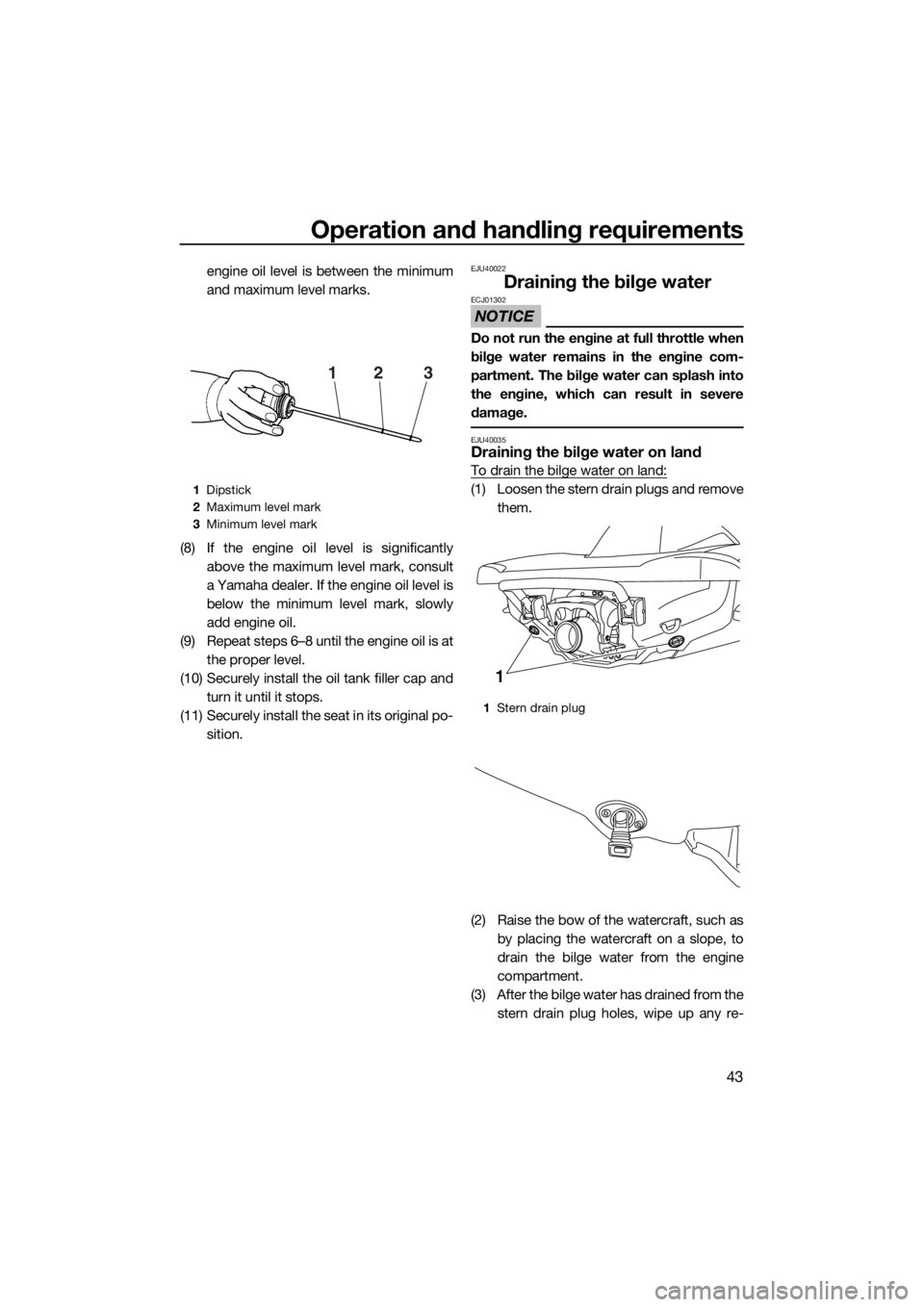
Operation and handling requirements
43
engine oil level is between the minimum
and maximum level marks.
(8) If the engine oil level is significantly
above the maximum level mark, consult
a Yamaha dealer. If the engine oil level is
below the minimum level mark, slowly
add engine oil.
(9) Repeat steps 6–8 until the engine oil is at
the proper level.
(10) Securely install the oil tank filler cap and
turn it until it stops.
(11) Securely install the seat in its original po-
sition.EJU40022
Draining the bilge water
NOTICE
ECJ01302
Do not run the engine at full throttle when
bilge water remains in the engine com-
partment. The bilge water can splash into
the engine, which can result in severe
damage.
EJU40035Draining the bilge water on land
To drain the bilge water on land:
(1) Loosen the stern drain plugs and remove
them.
(2) Raise the bow of the watercraft, such as
by placing the watercraft on a slope, to
drain the bilge water from the engine
compartment.
(3) After the bilge water has drained from the
stern drain plug holes, wipe up any re-1Dipstick
2Maximum level mark
3Minimum level mark
213
1Stern drain plug
1
UF2P72E0.book Page 43 Tuesday, August 26, 2014 10:08 AM
Page 50 of 94
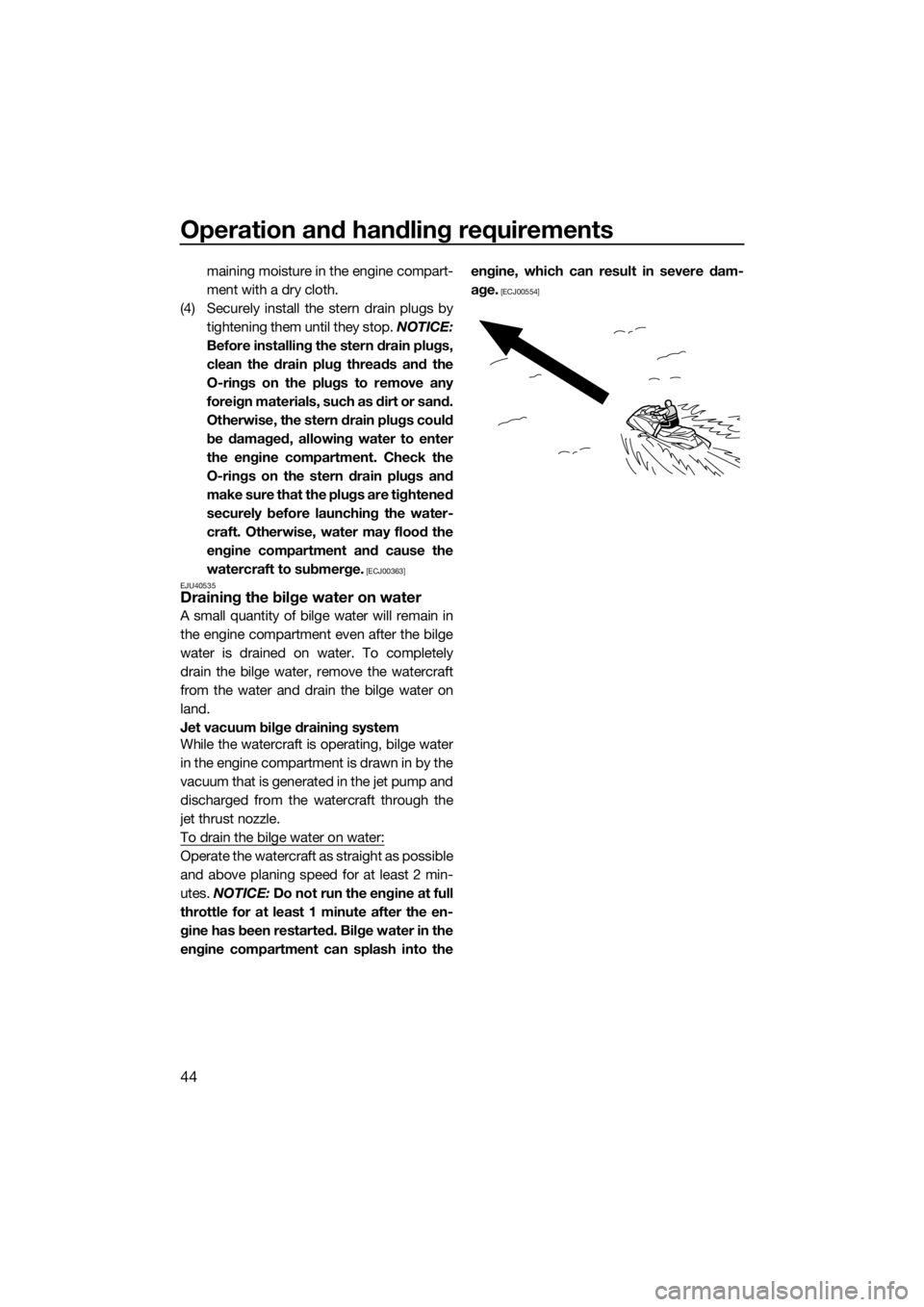
Operation and handling requirements
44
maining moisture in the engine compart-
ment with a dry cloth.
(4) Securely install the stern drain plugs by
tightening them until they stop. NOTICE:
Before installing the stern drain plugs,
clean the drain plug threads and the
O-rings on the plugs to remove any
foreign materials, such as dirt or sand.
Otherwise, the stern drain plugs could
be damaged, allowing water to enter
the engine compartment. Check the
O-rings on the stern drain plugs and
make sure that the plugs are tightened
securely before launching the water-
craft. Otherwise, water may flood the
engine compartment and cause the
watercraft to submerge.
[ECJ00363]
EJU40535
Draining the bilge water on water
A small quantity of bilge water will remain in
the engine compartment even after the bilge
water is drained on water. To completely
drain the bilge water, remove the watercraft
from the water and drain the bilge water on
land.
Jet vacuum bilge draining system
While the watercraft is operating, bilge water
in the engine compartment is drawn in by the
vacuum that is generated in the jet pump and
discharged from the watercraft through the
jet thrust nozzle.
To drain the bilge water on water:
Operate the watercraft as straight as possible
and above planing speed for at least 2 min-
utes. NOTICE: Do not run the engine at full
throttle for at least 1 minute after the en-
gine has been restarted. Bilge water in the
engine compartment can splash into theengine, which can result in severe dam-
age.
[ECJ00554]
UF2P72E0.book Page 44 Tuesday, August 26, 2014 10:08 AM
Page 52 of 94

First-time operation
46
EJU32786
Engine break-in
NOTICE
ECJ00432
Failure to perform the engine break-in
could result in reduced engine life or even
severe engine damage.
The engine break-in is essential to allow the
various components of the engine to wear
and polish themselves to the correct operat-
ing clearances. This ensures proper perfor-
mance and promotes longer component life.
To perform the engine break-in:
(1) Check the engine oil level. (See page 42
for information on checking the engine
oil level.)
(2) Launch the watercraft and start the en-
gine. (See page 57 for information on
starting the engine.)
(3) For the first 5 minutes, operate with the
engine at idling speed.
(4) For the next 30 minutes, operate with the
engine speed below 5000 r/min.
(5) For the next 1 hour, operate with the en-
gine speed below 6500 r/min.
After the engine break-in is complete, the wa-
tercraft can be operated normally.
UF2P72E0.book Page 46 Tuesday, August 26, 2014 10:08 AM
Page 53 of 94

Pre-operation checks
47
EJU31982
WARNING
EWJ00412
Failure to inspect or maintain the watercraft properly increases the possibility of an ac-
cident or damage to the watercraft. Do not operate the watercraft if you find any prob-
lem. If a problem cannot be corrected by the procedures provided in this manual, have
the watercraft inspected by a Yamaha dealer.
EJU41234Pre-operation checklist
Before using this watercraft, be sure to perform the checks in the following checklist.
ITEM ROUTINE PAGE
PRE-LAUNCH CHECKS
Engine compartmentVentilate the engine compartment.
Check inside the engine compartment for damage.49
Fuel systemCheck the fuel system for leakage.
Check the fuel level in the fuel tank.49
Water separatorCheck the water separator for water. 49
Engine unitCheck the exterior of the engine unit for damage. 49
Engine oil levelCheck the engine oil level. 49
Bilge waterCheck the engine compartment for bilge water. 50
BatteryCheck the battery connections and electrolyte level. 50
Steering systemCheck the steering system for proper operation. 50
Reverse system (V1 Sport)Check the reverse system for proper operation. 51
Throttle leverCheck the throttle lever for proper operation.
Check the throttle lever free play.52
Engine shut-off cord (lan-
yard)Check the engine shut-off cord (lanyard) for dam-
age.52
SwitchesCheck the start switch, engine stop switch, and en-
gine shut-off switch for proper operation.53
Storage compartmentsCheck the storage compartments for damage and
water.53
Fire extinguisher holder,
cover, and bandCheck the fire extinguisher holder, cover, and band
for damage.53
Fire extinguisherCheck the condition of the fire extinguisher. 53
Safety equipmentCheck that safety equipment meeting the applica-
ble regulations is on board.54
Hull and deckCheck the hull and deck for damage. 54
Jet intakeCheck the jet intake for damage and clogging. 54
Stern drain plugsCheck the stern drain plugs for damage and foreign
material and check that they are securely installed.54
HoodCheck that the hood is securely closed. 54
SeatCheck that the seat is securely installed. 34
UF2P72E0.book Page 47 Tuesday, August 26, 2014 10:08 AM
Page 54 of 94

Pre-operation checks
48
TIP:
To ensure safety and reliability, pre-operation checks should be made each time the water-
craft is used.
POST-LAUNCH CHECKS
Cooling water pilot outletCheck that water is discharged from the cooling
water pilot outlet while the engine is running.55
Multifunction information
centerCheck the multifunction information center for prop-
er operation.55
Engine idling speedCheck the engine idling speed. 55 ITEM ROUTINE PAGE
UF2P72E0.book Page 48 Tuesday, August 26, 2014 10:08 AM
Page 55 of 94
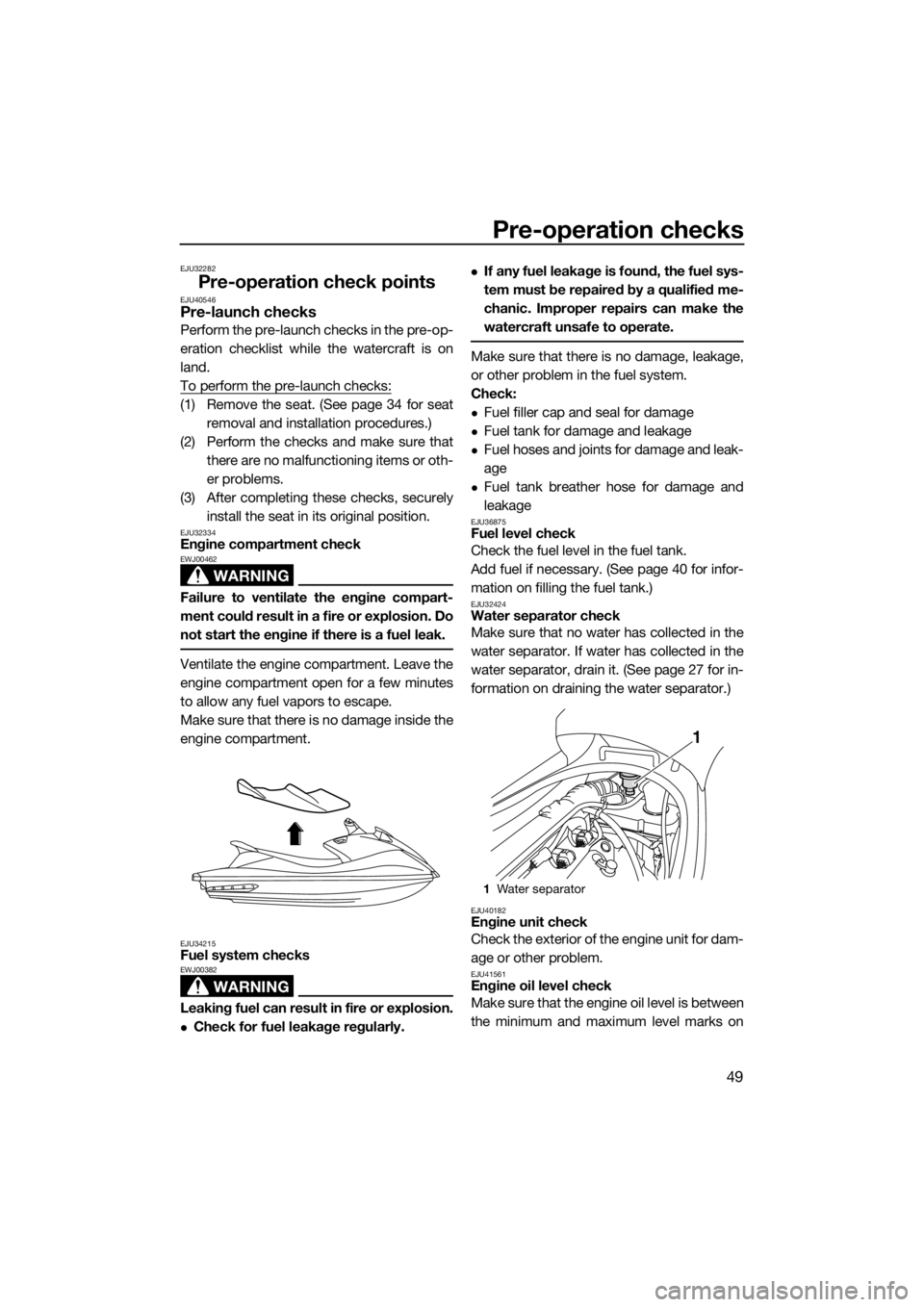
Pre-operation checks
49
EJU32282
Pre-operation check pointsEJU40546Pre-launch checks
Perform the pre-launch checks in the pre-op-
eration checklist while the watercraft is on
land.
To perform the pre-launch checks:
(1) Remove the seat. (See page 34 for seat
removal and installation procedures.)
(2) Perform the checks and make sure that
there are no malfunctioning items or oth-
er problems.
(3) After completing these checks, securely
install the seat in its original position.
EJU32334Engine compartment check
WARNING
EWJ00462
Failure to ventilate the engine compart-
ment could result in a fire or explosion. Do
not start the engine if there is a fuel leak.
Ventilate the engine compartment. Leave the
engine compartment open for a few minutes
to allow any fuel vapors to escape.
Make sure that there is no damage inside the
engine compartment.
EJU34215Fuel system checks
WARNING
EWJ00382
Leaking fuel can result in fire or explosion.
Check for fuel leakage regularly.
If any fuel leakage is found, the fuel sys-
tem must be repaired by a qualified me-
chanic. Improper repairs can make the
watercraft unsafe to operate.
Make sure that there is no damage, leakage,
or other problem in the fuel system.
Check:
Fuel filler cap and seal for damage
Fuel tank for damage and leakage
Fuel hoses and joints for damage and leak-
age
Fuel tank breather hose for damage and
leakage
EJU36875Fuel level check
Check the fuel level in the fuel tank.
Add fuel if necessary. (See page 40 for infor-
mation on filling the fuel tank.)
EJU32424Water separator check
Make sure that no water has collected in the
water separator. If water has collected in the
water separator, drain it. (See page 27 for in-
formation on draining the water separator.)
EJU40182Engine unit check
Check the exterior of the engine unit for dam-
age or other problem.
EJU41561Engine oil level check
Make sure that the engine oil level is between
the minimum and maximum level marks on
1Water separator
1
UF2P72E0.book Page 49 Tuesday, August 26, 2014 10:08 AM